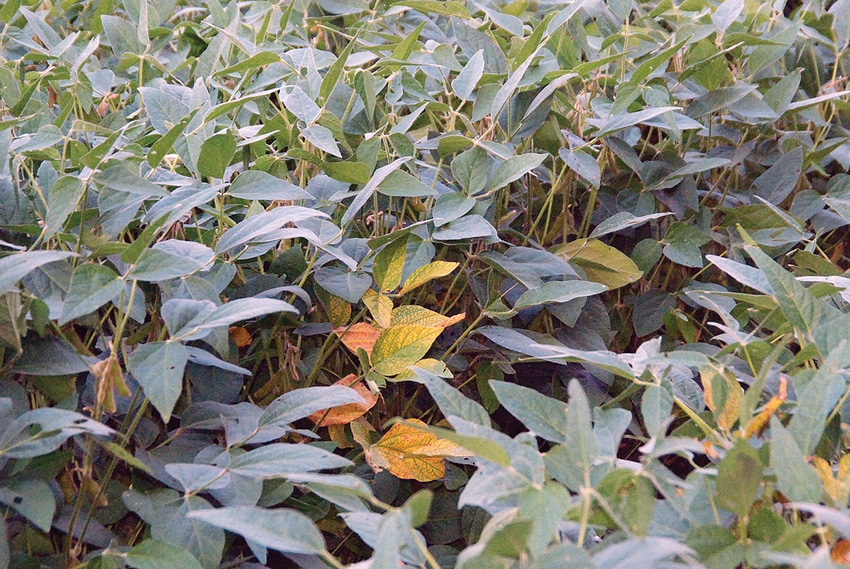
The Mid-South’s soybean “mystery malady” now has a name — taproot decline. Unfortunately, as those at the 2016 Tri-State Soybean Meeting heard, there remain many questions about treatment.
“When I started in 2007, I received numerous calls from consultants about a root-associated soybean disease that appeared different than the other root diseases in the Mid-South,” said Tom Allen, Mississippi State University plant pathologist. “Looking back, and based on some of the more prominent symptoms associated with this root disease, I think the disease was likely misdiagnosed as one of several other root-associated soybean diseases.
“When considering the specific time of year that most diseases occur, the vast majority of foliar diseases in Mississippi — and this also holds true for Arkansas and Louisiana — occur during reproductive growth stages.”
That doesn’t mean some of the root-associated diseases aren’t the result of infection that occurs earlier in the season. However, “the symptoms associated with those diseases are not generally observed until later in the growing season. The diseases that result from early infection but are not observed until advanced reproductive growth stages include Phytopthera root rot, charcoal rot, red crown rot, stem canker, SDS, and some nematode-related issues. In the field, the symptoms associated with these specific diseases are not generally observed until R5-plus.”
This new root-associated disease is interesting, said Allen, “because, quite frankly, if you know what you’re looking for the disease can be observed at both vegetative and reproductive growth stages. To properly observe and diagnose this new root disease you’ll have to spend a lot of time on your hands and knees looking at potentially infected plants.”
There is now a name “for what we have previously referred to as ‘the mystery disease.’ We are now referring to this particular disease as taproot decline. My colleagues from other states waited to name the disease until we were all on the same page to try and prevent confusion between states.”
Appearance
What does taproot decline look like?
“Well, it can be confusing because there are a number of diseases that produce similar symptoms. Sudden death syndrome looks similar, but there are differences.
“Interveinal chlorosis is one of the most common symptoms associated with taproot decline. Typically, interveinal chlorosis can be observed in a single plant or small clumps of plants together scattered around in a single field.
“When someone says, ‘Last week I came by this field and saw nothing. Now, the crop is beyond R5-and-a-half and I’m seeing issues on a few plants here and there,’ that’s when I think, ‘taproot decline.’
“More often than not, SDS will be a pickup truck-sized area in a field. Or, if you have a soybean cyst nematode problem, the area will be large — sometimes the size of a football field.”
Taproot decline can oftentimes appear to have killed the plants at R6 to R6-and-a-half. “One way to generally rule out SDS and potentially confirm the presence of taproot decline: grab the stem of a plant and jerk the plant out of the ground aggressively. If the taproot, or a portion of the taproot, stays in the ground, then it is more often than not taproot decline. Doing that with SDS-affected plants won’t leave the root system in the ground (at least in the Mid-South) unless something else — hardpan, drought — is occurring in the field.”
On plants exhibiting symptoms aboveground, “a thick black growth at the base of the stem and taproot along the soil line can oftentimes be observed. In some cases, there can be a thick, ropy white mycelium. If you use a pocketknife and cut into the stem, the vascular tissues will be brown and slightly discolored. The biggest problem with this particular symptom is that several soybean diseases cause a vascular discoloration.
“In some years, I’ve observed taproot decline in fields as early as V6 to V8. But to see the disease that early you really have to know what you’re looking for and fields exhibiting symptoms at that early growth stage have generally been observed to contain the disease in a previous season. If you’re observing taproot decline at V6 to V8, infection by the fungus likely occurred before that particular growth stage. If you get to the R6, it rarely means there will be no soybean production on the plant.”
Allen said to date, taproot decline has been observed in all the soil types throughout the Mid-South regardless of irrigation, dryland, furrow-irrigated, and variety planted. “At the end of this talk, you might say, ‘Darn, there’s a new disease and we don’t know how to control it.’ Well, at this point, we simply do not have an answer.”
Going forward
So where does that leave things?
Mid-South university researchers “have essentially created a task force,” said Allen. “The first step is to determine the specific fungus that is causing this disease. Unfortunately, dealing in the mycological world can be like spelunking when you drop your flashlight. If it isn’t something widely reported or in literature, it can be very difficult to determine what is causing the disease. That’s especially true if the fungus responsible doesn’t produce spores.
“I think it is safe to say we know the genus for the fungus. Now, we’ll attempt to determine if this is a new species.
“For our future efforts, we’re planning on conducting some field trials. For the 2016 season we will likely do some field trials to determine whether some currently available soybean cultivars are more susceptible to the fungus than others. At present, no information is available on whether or not in-furrow fungicides or seed treatment would be beneficial to manage taproot decline.”
About the Author(s)
You May Also Like




